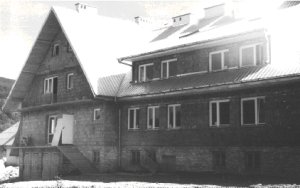Bieszczady still endangered
Open Letter to the Nature Conservator of the Krosno Province
Nowadays, it is not necessary to persuade anybody that the most valuable landscape and natural environment in the Bieszczady was the "bieszczad". It included Wołosate, Tworylne, Krywe, Hulskie, and a few dozen old Lemkian or Bojkian villages in the mountain stream valleys. These old villages were established according to Valachian law and have been deserted for half a century, overgrown by hardy ryegrass, shrubs, and weeds.
It was Mieczysław Orłowicz who first brought the "bieszczad" to my attention when, in July, 1958, he signed the GOT book for me, a beginning amateur of the Bieszczady at the time. I have it until this day. Sir Edmund Hillary, a conqueror of Mt. Everest, was fascinated by the "bieszczad" -- not the Bieszczady per se. The majority of foreign tourists with whom I have discussed this topic during my thirty-year career as a guide feel the same way.
Unfortunately, the "bieszczad" does not really exist anymore, and this state of affairs is your fault, Mr. Nature Conservator of the Krosno Province -- yours and your predecessors'.
The idiotic management of these areas and the building of gigantic farms, wood industry complexes, and concentration camp-style workers' barracks should not have been allowed.
The treatment of alder trees as "forest weeds" and the actions of settlement and permits to farm where it has not been profitable for a long time should not have been allowed.
The thoughtless transfer to the Bieszczady of solutions and organization patterns of mass tourism which may have worked in the Alps, the Caucasus, or the Pyrenees, but are not appropriate for the Bieszczady, should not have been allowed. Berehy and Ustrzyki Górne will never be a Chamonix-Mont Blanc or a Zermatt, or even a Zakopane. Thank Goodness for this.
For this reason, Mr. Nature Conservator, I do not understand how you could allow the construction of a hotel in Ustrzyki Górne -- a hotel which is fatally designed, is situated in the center of the Bieszczady National Park, and worked all last season without a sewage-treatment plant.
Nor do I understand how, in this same town, a parish house could be built on the site of the old Orthodox Church of St Michael the Archangel which was destroyed in the 1950s. A multi-story building with impressive cubic area, a few dozen window holes, and hectares of tin roof cover will became a dominant feature of the Bieszczady capital's scenery. A Catholic parish house on the profaned Orthodox Cemetery!!!!! Would it be possible to render a worse service for the idea of Christian ecumenism and the reconciliation between the Ukrainian and Polish nations -- a reconciliation which we are very keen on nowadays and which is necessary for both nations.
After all, in the same parish and not far away there are deserted hotel buildings in Zawratnica and Tarnawa. Let them be adapted for the parish house. The as yet unfinished building should be diminished before it becomes an international scandal. You, Mr. Nature Conservator, should issue an appropriate order, because the building is drastically against the law which you are obliged to follow (Art. 36 of the Nature Protection Act of the16th of October, 1991). The Act which, particularly for you, should be the Decalogue to live by is being systematically broken and ignored by the present management of the Bieszczady National Park.
If in the Bieszczady we would really like to have a National Park and not an amusement park, as it is called by the local press, we must decide immediately (and even then it will be a few years too late) about the following issues:
- Closing the road that loops around Bieszczady on the stretch from Wetlina to Stuposiany to cars without catalytic converters. Cars belonging to local people (from Lutowiska and Cisna) and public transportation vehicles would be exempt from this rule for the next couple of years.
- Demolishing all buildings, both those which are inhabited and those which are not yet finished, in the center of the Park in the Wołosate Valley. Tenants of tied flats, which are occupied by the rapidly increasing staff of the Bieszczady National Park, can be displaced to numerous flats in Tarnawa and Czarna which are empty after IGLOPOL's liquidation [editor's note: IGLOPOL was a food production industry in the Bieszczady region. It is now bankrupt]. The displacement of people who live in the protected areas is a generally applied practice and is taking place in Kampinoski National Park and elsewhere.
- Carrying out the correction of the park border and expanding it to 42 thousand hectares, while at the same time returning 1200 hectares of spruce forest in the Sianki region to the Stuposiany forest inspectorate.
In the opinion of the Regional State Forest Management, the management of the Biesczady National Park has turned out to be unprepared to carry out proper forest management. They have introduced wasteful methods using heavy equipment, which is especially dangerous in the region close to the source of the San River. There is almost no afforestation (only 3%). Supervision of the amount of wood removal is insufficient. There are more and more rumors about Steyer drivers who during the night transport big old trees from Negrylow and Sychlowaty to the Rabe sawmill and "forget" to add a zero in a way bill for a load which amounts to about 50 cubic meters.
The management of the Bieszczady National Park has spent tens of billions of złotys -- money which was transferred by the National Fund for Environmental Protection and which came from tax-payers' pockets -- for working out the park protection plans before fixing the area and the borders of the park. This goes beyond uneconomical management.

The parish house in Ustrzyki Górne
The money should be used to buy IGLOPOL's agricultural and forest properties situated in the San valley, which closely surround the Bieszczady National Park and thus Tworylne, Krywe, Hulskie, Beniowa, and Bukowiec. These properties were put up for sale by the Agricultural Property Agency of the State Treasury. Together the properties amount to somewhat less than 2000 hectares, and the Agency would like to sell them for 2 - 4 billion zlotys, just a fraction of the sum which was thoughtlessly frittered away.
It is obvious that before the tourist season comes, Mr. Nature Conservator, you should prohibit the sale of alcohol in shops and shelter houses, noisy dances, the training of paragliders on the mountain pastures, and berry picking in the natural monument reservations.
The Bieszczady do not belong to us, Mister Nature Conservator. Surely, they do not belong to you, and they do not belong to me, either. They do not belong to anybody from our generation, and for that reason we must not destroy, litter, or trample them, or permit them to be converted into an outlandish seasonal resort.
The Bieszczady, the most beautiful part of the Carpathians range, which determine the biological diversity of the European continent, belong above all to future generations. And all administrative decisions made today should take these future generations into consideration.
Such decisions are expected from you, Mr. Krosno Nature Conservator.
Witold Stanisław Michałowski
Former Proxy of the Environmental Protection Minister
for the East Carpathians International Biosphere Reserve Affairs






 Wydawnictwo „Zielone Brygady” - dobre z natury. Niektóre prawa zastrzeżone.
Wydawnictwo „Zielone Brygady” - dobre z natury. Niektóre prawa zastrzeżone.